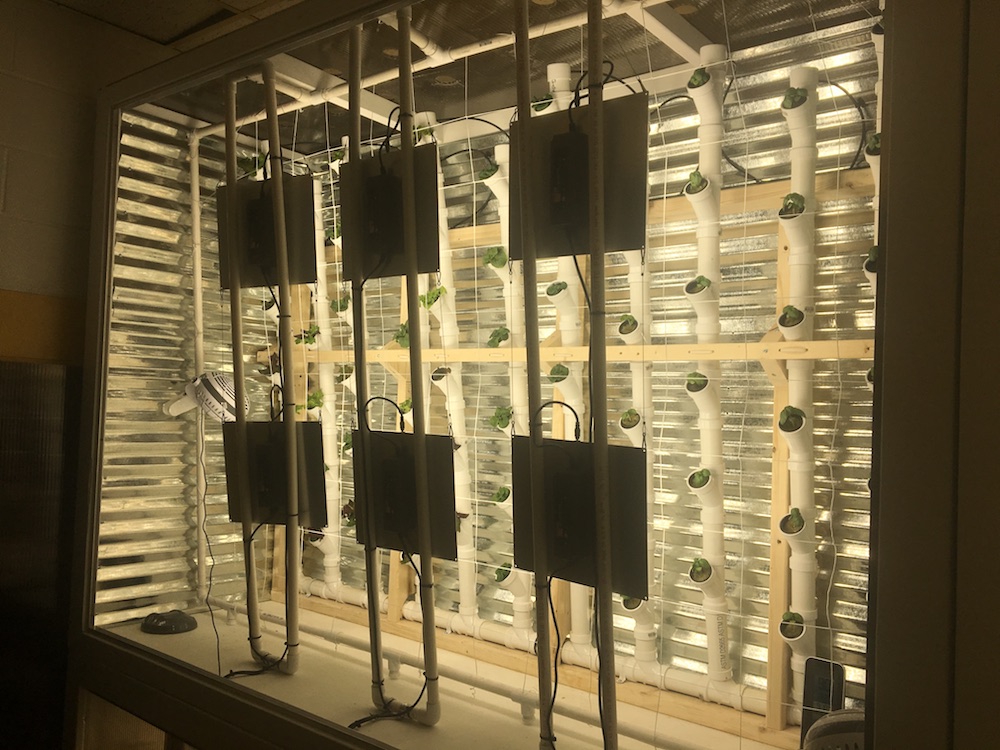Greenport High School unveils aquaponics system for fresh veggies, fruits

Beginning this week, Greenport High School students will have access to fresh fruits and vegetables right next to the school’s cafeteria.
On Monday, Greenport unveiled the school district’s student-constructed aquaponics system, a unit of PVC pipes, water flow, and LED lights that operate as a garden inside the school building.
Aquaponics blends aquaculture, or growing fish, with hydroponics, or growing plants without soil. The fish waste is turned into compost which provides nutrients to the plants.
The two-section unit in Greenport holds over 130 individual pods, each with its own plant. Select fruits and vegetables will be used in cafeteria lunches. The class also completed a unit that will be placed in Southold High School.
The school district paid for supplies and equipment through the state’s Farm-to-School grant, which offered $68,820 to districts on the East End in 2018 to improve access to fresh food this year.
“This all started two years ago in the Design, Drawing and Production class,” technology teacher Mike Davies said. “We kind of took the reins with it — we got the research out of the way and decided to make a vertical hydroponics system because we wanted to conserve space and have it inside the classroom and next to the cafeteria.”
Mr. Davies said the students in the 2017 elective class completed research on low-cost lighting and energy-efficient equipment.
Senior Andria Skrezec, 17, who was in the DDP class last year, said she helped plan the budget for the unit. For her, it’s incredible to see the project come together after two years in the making.
“Back then … we looked at different designs online as to what would work out best and be most efficient for the school,” Andria said. “It feels good to see it done. I feel like I didn’t think it would go through.”
The Greenport unit is currently growing black leaf lettuce and arugula. There’s an incubator at the base of the unit intended for seed germination, Mr. Davies said. After about 2-4 weeks in the incubator, seeds are transported into the pods above, he said. The incubator is holding cilantro, basil, strawberries, butter lettuce and a mesclun mix.
As soon as the pods bud a flower, Mr. Davies said, the plants are removed and replaced with a new seedling. The attached tank may also need to be changed to provide appropriate nutrients for the plants.
Junior Mack Mezynieski, 17, enrolled in the DDP class, works locally in a material-supply yard. He said he used his job experience to help construct the unit.
“I put in a bunch of the back panels and sheet metal; I was cutting a bunch of the Plexiglas tops,” he said. “But everyone helped with a bunch of parts — we’ve been working on this every ninth period and doing stuff on it every day.”
Junior Courtney Martocchia, 16, enrolled in the DDP class, said this year’s team completed hands-on construction in addition to research.
“We did everything from painting the wood, cutting the wood, cutting the metal, we actually cut in the individual pods,” Courtney said. “Seeing it completed is really amazing.”
Photo caption: The new aquaponics growing system allows students to operate a garden inside the school building. (Kate Nalepinski photo)









